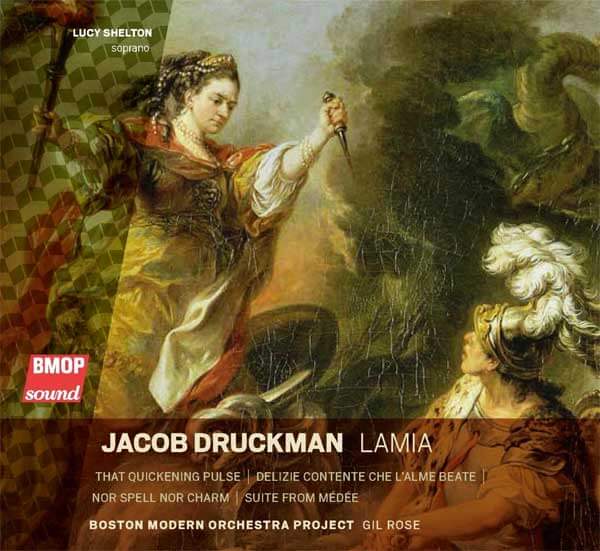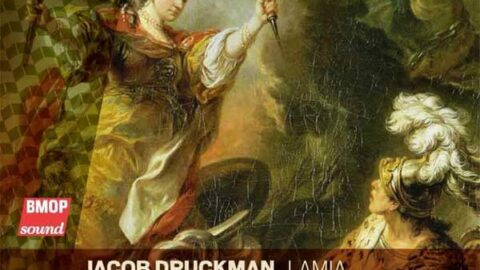 This recording by the Boston Modern Orchestra Project captures several of Jacob Druckman (1928-1996)’s later works. While his Lamia, performed here by soprano Lucy Shelton, headlines the disc, the recording is structured as an all-Druckman concert that succeeds with aplomb. Mixing Druckman’s original works with arrangements of baroque pieces by Cavalli and Charpentier, the performance opens with That Quickening Pulse in its rightful place as a concert-opener. Composed in 1988, it is also a solid introduction to Druckman’s approach to non-electronic composition, which included borrowings and homages to past forms and works while still engaging with tonal centricity and traditional harmonic language. That Quickening Pulse calls for an orchestra with triple winds and, and progresses in a pattern that alternates between tutti passages that propel the work forwards and brief, calm interludes with sparser textures. This performance is precise and crisp, showcasing the variation in timbre required by the work. The forward motion never ceases and the moments of repose and activity are highly coherent, linked together by the ensemble’s energy and focus.
This recording by the Boston Modern Orchestra Project captures several of Jacob Druckman (1928-1996)’s later works. While his Lamia, performed here by soprano Lucy Shelton, headlines the disc, the recording is structured as an all-Druckman concert that succeeds with aplomb. Mixing Druckman’s original works with arrangements of baroque pieces by Cavalli and Charpentier, the performance opens with That Quickening Pulse in its rightful place as a concert-opener. Composed in 1988, it is also a solid introduction to Druckman’s approach to non-electronic composition, which included borrowings and homages to past forms and works while still engaging with tonal centricity and traditional harmonic language. That Quickening Pulse calls for an orchestra with triple winds and, and progresses in a pattern that alternates between tutti passages that propel the work forwards and brief, calm interludes with sparser textures. This performance is precise and crisp, showcasing the variation in timbre required by the work. The forward motion never ceases and the moments of repose and activity are highly coherent, linked together by the ensemble’s energy and focus.

That Quickening Pulse is followed by Delizie Contente Che L’Alme Beate, Druckman’s1985 re-working of the aria from Francesco Cavalli’s 1649 opera Il Giasone. While the original is scored for castrato and chamber orchestra, Druckman arranges it for English horn, strings, and harpsichord. He lowers the tessitura while retaining the original form or the aria, giving it a darker and more somber presence. The booklet accompanying the CD does not make clear who the soloist is in this recording, but I have rarely heard playing as even and beautiful as is presented here: the English horn is the epitome of melancholy and deep resonance.
Composed for mezzo-soprano Jan DeGaetani, with whom Druckman had a long collaborative relationship, Nor Spell Nor Charm began as a short song called “Nor Spell” for voice and English horn in 1989, the year of the singer’s death. With text taken from Shakespeare’s A Midsummer Night’s Dream, the work conjures up a supernatural world through the use of sparse instrumentation and sudden entrances and exits. Because DeGaetani was too ill to perform the song, however, Druckman reworked it in 1990 for chamber orchestra and expanded it into a memorial for her. An introduction sets the scene, followed by development of a rhythmic motif of septuplets. Play between clarinets and oboe and between horns and low strings pushes the work into a plaintive section. Here the ensemble as a whole begins a move to a higher, more strained tessitura, with the strings moving in quick, tight gestures and the winds sighing at the tops of their registers in a keening gesture for the lost DeGaetani. There is little resolution in a traditional sense: instruments fall away without returning to tonal centers, and rhythms trail off into nothingness. Nor Spell Nor Charm is a demanding piece, and is done well here. It is often difficult to reach the top pitches Druckman calls for with control, but the wind players here achieve the perfect balance between richness and pain in their sonorities. While the strings aren’t as tight as they could be, they nonetheless create the atmospheric effects Druckman indicates with the score. As a whole, the work is compelling and tragic; in this performance, it is also a testament to musicians willing and able to treat twentieth-century music with the same care and preparation as older works.
Like Delizie Contente Che L’Alme Beate, Druckman’s Suite from Médée, also from 1985, arranges an existing baroque work, in this case five movements drawn from Charpentier’s opera. Druckman’s handling of the material is careful and respectful, using a similar ensemble to that of Charpentier’s. The Ouverture, light, airy, and inestimably French, is transposed and slightly slower than most performances of other editions, but remains crisp and clean. The Prelude to Act III, Scene V, which makes up the second movement of the Suite, is well-played if not particularly moving, but the extractss from the Prologue that comprise the third movement are charming and fun. The brass in particular shine here with excellent tone and intonation. The orchestra is perhaps best in the fourth movement, the stately Loure, a dance. More so than in the previous movements, there is a cohesion of line and breath throughout the ensemble, although the precision that marked the technically more difficult Quickening Pulse remains somewhat lacking. It is in this penultimate movement that the audience can really hear the devotion to the French baroque style that Druckman honored with this arrangement. The Suite concludes with the “Passepied and Choeur,” which, while pleasant, sounds like any other modern-instrument group playing older music. Unlike the Cavalli aria arrangement, this arrangement does little to present the original music in a new way. It’s nice to have it recorded for posterity, but it’s not a revealing work, either about the original or Druckman.

Lamia is the final work on the program, and the only one with voice. Composed in 1986 for DeGaetani, it, like Médée, explores Greek myth and legend, in this instance focusing on the sorceress Lamia. Of the work, Druckman wrote that he was inspired by DeGaetani, who “gave a particularly magical performance….in which everything that sounded and befell seemed to be the direct result of her will and her powers. Lamia is a celebration of those powers.” Using seven texts in various languages from folk magic, Ovid’s Metamorphoses, Tristan and Isolde, a sixteenth-century treatise on witchcraft, and Cavalli’s Il Giasone, Druckman created a masterpiece of musical incantations and atmosphere. The work is in four movements, beginning with a folk spell for courage and then moving to a conjuration for a dream in which to see one’s future husband, a spell against death, and a three-part finale including an incantation from Medea, Isolde’s conjuring, and a ward against thieves.
This is perhaps Druckman at his most original. The music flows easily with the words, and the instrumental surroundings support, create, and develop motifs and themes alongside the singer, as if they were together pulling them from the text and air. Dialogues between instruments and instrument groups offer contrast and signal important materials to the audience as Druckman shifts from one collective timbre to another, or moves between textures. Lush orchestration gives way to passages for soli; throughout, the use of percussion and familiar motifs introduced at the beginning hold the various elements of the movements together.
Both Shelton and her instrument-playing comrades are called upon to execute sounds that extend traditional technique, and do so with grace and ease. Because of the work’s potential for disjunctedness between short, intense sections, it is difficult for a performance to cohere, but this one does with refinement and polish. The theatricality of the piece gives Shelton the opportunity to fully inhabit the sorceress of the title, and she does so completely. In the final movement, in particular, the listener can easily hear the power she wields and the glee with which she does so. The orchestra is outstanding throughout Lamia, scaling the most technically difficult materials in always-musical ways, never succumbing to treating such passages as exercises but always imbuing them with character.
For the performance of Lamia alone, this recording is worth owning. With the inclusions of That Quickening Pulse and NorSpell Nor Charm, it is a must-have for any admirer of twentieth-century music, and the two baroque arrangements make it essential for the true Druckman fan or completist. The Boston Modern Orchestra Project has done an excellent job with this recording, and I look forward to future releases of Druckman from them.
Jacob Druckman: Lamia (also includes That Quickening Pulse, Delizie Contente Che L’Alme Beate, Nor Spell Nor Charm, Suite from Médée). Boston Modern Orchestra Project led by Gil Rose and featuring Lucy Shelton, soprano. (BMPO Sound, 2013)
























